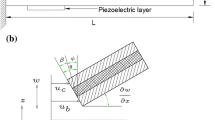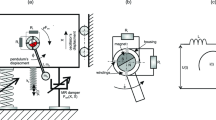Abstract
In this paper, dynamic analysis of an active nonlinear vibration absorber using lead zirconate titanate (PZT) stack actuator has been carried out considering time delay in the acceleration feedback. Here the primary system is modelled as a harmonically base excited system with a nonlinear spring, damper and mass which is subjected to an external harmonic force. The smart absorber consists of a nonlinear spring, mass and damper system along with a linear spring connected in series with the PZT stack actuator. In the proposed model, the active control force is produced by the combination of spring and the PZT stack actuator which requires less voltage compared to that of the conventional system where the actuator is directly connected to the primary system and one can tune the frequency ratio of the absorber actively. The nonlinear governing equation of motion of the system is derived and solved by using a modified harmonic balance method. The steady-state response is obtained by using Newton’s method, and the stability of the system is studied using the reduced equations. It has been shown that the proposed novel vibration absorber which has inbuilt fail-safe design can absorb the vibration of the system more effectively with negligible damping than the available passive and active vibration absorbers. Also, the Den Hartog’s equal peaks are achieved when the primary system is subjected to both harmonic force and base excitation.




















Similar content being viewed by others
References
Dolatabadi, N., Theodossiades, S., Rothberg, S.J.: Passive control of piston secondary motion using nonlinear energy absorbers. J. Vib. Acoust. 139(5), 051009 (2017)
Reina, G., Rose, G.D.: Active vibration absorber for automotive suspensions: a theoretical study. Int. J. Heavy Veh. Syst. 23(1), 21–39 (2016)
Gong, D., Zhou, J.S., Sun, W.J.: On the resonant vibration of a flexible railway car body and its suppression with a dynamic vibration absorber. J. Vib. Control 19(5), 649–657 (2013)
El-Sayed, A.T., Kamel, M., Eissa, M.: Vibration reduction of a pitch-roll ship model with longitudinal and transverse absorbers under multi excitations. Math. Comput. Model. 52(9–10), 1877–1898 (2010)
Yong, C., Zimcik, D.G., Wickramasinghe, V.K., Nitzsche, F.: Research of an active tunable vibration absorber for helicopter vibration control. Chin. J. Aeronaut. 16(4), 203–211 (2003)
Ebrahimzade, N., Dardel, M., Shafaghat, R.: Performance comparison of linear and nonlinear vibration absorbers in aeroelastic characteristics of a wing model. Nonlinear Dyn. 86(2), 1075–1094 (2016)
Rodriguez, J., Cranga, P., Chesne, S., Gaudiller, L.: Hybrid active suspension system of a helicopter main gearbox. J. Vib. Control 24(5), 956–974 (2018)
Shakeri, S., Samani, F.S.: Application of linear and nonlinear vibration absorbers in micro-milling process in order to suppress regenerative chatter. Nonlinear Dyn. 89(2), 851–862 (2017)
Miguélez, M.H., Rubio, L., Loya, J.A., Fernández-Sáez, J.: Improvement of chatter stability in boring operations with passive vibration absorbers. Int. J. Mech. Sci. 52(10), 1376–1384 (2010)
Viguié, R., Kerschen, G., Golinval, J.C., McFarland, D.M., Bergman, L.A., Vakakis, A.F., Van de Wouw, N.: Using passive nonlinear targeted energy transfer to stabilize drill-string systems. Mech. Syst. Signal Process. 23(1), 148–169 (2009)
Sun, J.Q., Jolly, M.R., Norris, M.A.: Passive, adaptive and active tuned vibration absorbers—a survey. J. Mech. Des. 117(B), 234–242 (1995)
Soto, M.G., Hojjat, A.: Tuned mass dampers. Arch. Comput. Methods Eng. 20(4), 419–431 (2013)
Munteanu, L., Chiroiu, V., Sireteanu, T.: On the response of small buildings to vibrations. Nonlinear Dyn. 73(3), 1527–1543 (2013)
Frahm, H.: Device for damping vibrations of bodies, US Patent Nos. 989, 958, pp. 3576–3580 (1911)
Ormondroyd, J., Den Hartog, J.P.: The theory of the dynamic vibration absorber. J. Appl. Mech. 50(7), 9–22 (1928)
Den Hartog, J.P.: Mechanical Vibrations. Dover Publications Inc., New York (1985)
Asami, T.: Optimal design of double-mass dynamic vibration absorbers arranged in series or in parallel. J. Vib. Acoust. 139(1), 011015 (2017)
Cheung, Y.L., Wong, W.O.: H\(_\infty \) and H\(_2\) optimizations of a dynamic vibration absorber for suppressing vibrations in plates. J. Sound Vib. 320(1–2), 29–42 (2009)
Buki, E., Katz, R., Zacksenhouse, M., Schlesinger, I.: Vib-bracelet: a passive absorber for attenuating forearm tremor. Med. Biol. Eng. Comput. 56, 923–930 (2018)
Wong, W.O., Fan, R.P., Cheng, F.: Design optimization of a viscoelastic dynamic vibration absorber using a modified fixed-points theory. J. Acoust. Soc. Am. 143(2), 1064–1075 (2018)
Fisco, N.R., Adeli, H.: Smart structures: part II—hybrid control systems and control strategies. Sci. Iran. 18(3), 285–295 (2011)
Viana, F.A.C., Kotinda, G.I., Rade, D.A., Steffen, J.V.: Tuning dynamic vibration absorbers by using ant colony optimization. Comput. Struct. 86(13–14), 1539–1549 (2008)
Krenk, S., Høgsberg, J.: Tuned mass absorber on a flexible structure. J. Sound Vib. 333(6), 1577–1595 (2014)
Cheung, Y.L., Wong, W.O., Cheng, L.: A subsystem approach for analysis of dynamic vibration absorbers suppressing broadband vibration. J. Sound Vib. 342, 75–89 (2015)
Pham, T.T., Pernot, S., Lamarque, C.H.: Competitive energy transfer between a two degree-of-freedom dynamic system and an absorber with essential nonlinearity. Nonlinear Dyn. 62(3), 573–592 (2010)
Mohanty, S., Dwivedy, S.K.: Linear and nonlinear analysis of piezoelectric based vibration absorber with acceleration feedback. Proc. Eng. 144, 584–591 (2016)
Berardengo, M., Cigada, A., Guanziroli, F., Manzoni, S.: Modelling and control of an adaptive tuned mass damper based on shape memory alloys and eddy currents. J. Sound Vib. 349, 18–38 (2015)
Wang, X., Yang, B., Guo, S., Zhao, W.: Nonlinear convergence active vibration absorber for single and multiple frequency vibration control. J. Sound Vib. 411, 289–303 (2017)
Kim, S.M., Wang, S., Brennan, M.J.: Dynamic analysis and optimal design of a passive and an active piezo-electrical dynamic vibration absorber. J. Sound Vib. 330(4), 603–614 (2011)
Weber, F., Maślanka, M.: Frequency and damping adaptation of a TMD with controlled MR damper. Smart Mater. Struct. 21(5), 055011 (2012)
Nguyen, S.D., Choi, S., Nguyen, Q.H.: A new fuzzy-disturbance observer-enhanced sliding controller for vibration control of a train–car suspension with magneto-rheological dampers. Mech. Syst. Signal Process. 105, 447–466 (2018)
Benacchio, S., Malher, A., Boisson, J., Touzé, C.: Design of a magnetic vibration absorber with tunable stiffnesses. Nonlinear Dyn. 85(2), 893–911 (2016)
Chatterjee, S.: Optimal active absorber with internal state feedback for controlling resonant and transient vibration. J. Sound Vib. 329, 5397–5414 (2010)
Fisco, N.R., Adeli, H.: Smart structures: part i—active and semi-active control. Sci. Iran. 18(3), 275–284 (2011)
Mallik, A.K., Chatterjee, S.: Principles of Passive and Active Vibration Control. East West Press, New Delhi (2014)
Bauomy, H.S.: Active vibration control of a dynamical system via negative linear velocity feedback. Nonlinear Dyn. 77(1–2), 413–423 (2014)
Cheung, Y.L., Wong, W.O., Cheng, L.: Design optimization of a damped hybrid vibration absorber. J. Sound Vib. 331, 750–766 (2012)
Habib, G., Detroux, T., Viguié, R., Kerschen, G.: Nonlinear generalization of Den Hartog’s equal-peak method. Mech. Syst. Signal Process. 52, 17–28 (2015)
Gatti, G.: Fundamental insight on the performance of a nonlinear tuned mass damper. Meccanica 53, 111–123 (2017)
Rizos, D., Feltrin, G., Motavalli, M.: Structural identification of a prototype pre-stressable leaf-spring based adaptive tuned mass damper: nonlinear characterization and classification. Mech. Syst. Signal Process. 25(1), 205–221 (2011)
Renault, A., Thomas, O., Mahé, H.: Numerical antiresonance continuation of structural systems. Mech. Syst. Signal Process. 116, 963–984 (2019)
Cirillo, G.I., Habib, G., Kerschen, G., Sepulchre, R.: Analysis and design of nonlinear resonances via singularity theory. J. Sound Vib. 392, 295–306 (2017)
Kučera, V., Pilbauer, D., Vyhlídal, T., Olgac, N.: Extended delayed resonators: design and experimental verification. Mechatronics 41, 29–44 (2017)
Bronkhorst, K.B., Febbo, M., Lopes, E.M., Bavastri, C.A.: Experimental implementation of an optimum viscoelastic vibration absorber for cubic nonlinear systems. Eng. Struct. 163, 323–331 (2018)
Carbajal, F.B., Navarro, G.S.: Active vibration in duffing mechanical systems using dynamic vibration absorbers. J. Sound Vib. 333, 3019–3030 (2014)
Ji, J.C.: Design of a nonlinear vibration absorber using three-to-one internal resonances. Mech. Syst. Signal Process. 42, 236–246 (2014)
Fallah, N., Ebrahimnejad, M.: Active control of building structures using piezoelectric actuators. Appl. Soft Comput. 13(1), 449–461 (2013)
Jalili, N., Knowles IV, D.W.: Structural vibration control using an active resonator absorber: modeling and control implementation. Smart Mater. Struct. 13(5), 998 (2004)
Chatterjee, S.: On the principle of impulse damper: a concept derived from impact damper. J. Sound Vib. 312(4–5), 584–605 (2008)
Zhao, Y.Y., Xu, J.: Using the delayed feedback control and saturation control to suppress the vibration of the dynamical system. Nonlinear Dyn. 67(1), 735–753 (2012)
Collette, C., Chesne, S.: Robust hybrid mass damper. J. Sound Vib. 375, 19–27 (2016)
Amer, Y.A., El-Sayed, A.T., Kotb, A.A.: Nonlinear vibration and of the Duffing oscillator to parametric excitation with time delay feedback. Nonlinear Dyn. 85(4), 2497–2505 (2016)
Olgac, N., Elmali, H., Hosek, M., Renzulli, M.: Active vibration control of distributed systems using delayed resonator with acceleration feedback. J. Dyn. Syst. Meas. Control 119, 380–389 (1997)
Rivaz, H., Rohling, R.: An active dynamic vibration absorber for a hand-held vibro-elastography probe. ASME J. Vib. Acoust. 129, 101–112 (2007)
Jalili, N., Olgac, N.: A sensitivity study on optimum delayed feedback vibration absorber. ASME J. Dyn. Syst. Meas. Control 122, 314–321 (2000)
Chatterjee, S.: Vibration control by recursive time delayed acceleration feedback. J. Sound Vib. 317(1–2), 67–90 (2008)
Habib, G., Kerschen, G., Stepan, G.: Chatter mitigation using the nonlinear tuned vibration absorber. Int. J. Non-linear Mech. 91, 103–112 (2017)
Nayfeh, A.H., Mook, D.T.: Nonlinear Oscillations. Wiley, Hoboken (2008)
Anh, N.D., Nguyen, N.X.: Design of TMD for damped linear structures using the dual criterion of equivalent linearization method. Int. J. Mech. Sci. 77, 164–170 (2013)
Xiang, P., Nishitani, A.: Optimum design and application of non-traditional tuned mass damper toward seismic response control with experimental test verification. Earthq. Eng. Struct. Dyn. 44(13), 2199–2220 (2015)
Yang, C., Li, D., Li, C.: Dynamic vibration absorbers for vibration control within a frequency band. J. Sound Vib. 330(8), 1582–1598 (2011)
Author information
Authors and Affiliations
Corresponding author
Ethics declarations
Conflict of interest
The authors declare that they have no conflict of interest.
Additional information
Publisher's Note
Springer Nature remains neutral with regard to jurisdictional claims in published maps and institutional affiliations.
Appendices
Appendix-I
Jacobian matrix obtained as
Appendix-II
a MATLAB SIMULINK model of the system b subsystem model for passive nonlinear vibration absorber and linear primary system with external harmonic excitation. c Subsystem model for active nonlinear vibration absorber and nonlinear primary system under harmonic external force and base excitation by time delay acceleration feedback
The SIMULINK model for the passive and active system are shown in Fig. 21
Rights and permissions
About this article
Cite this article
Mohanty, S., Dwivedy, S.K. Nonlinear dynamics of piezoelectric-based active nonlinear vibration absorber using time delay acceleration feedback. Nonlinear Dyn 98, 1465–1490 (2019). https://doi.org/10.1007/s11071-019-05271-4
Received:
Accepted:
Published:
Issue Date:
DOI: https://doi.org/10.1007/s11071-019-05271-4





